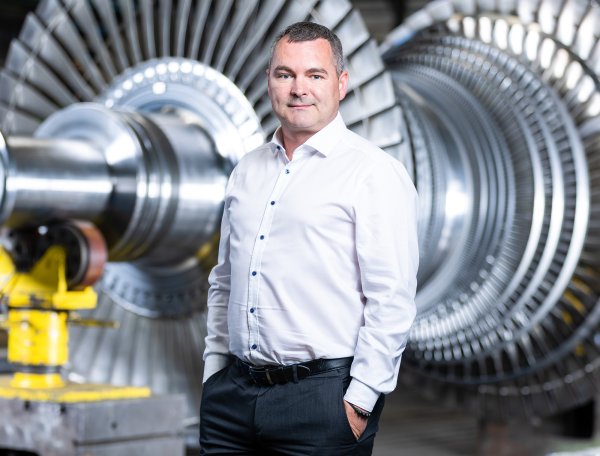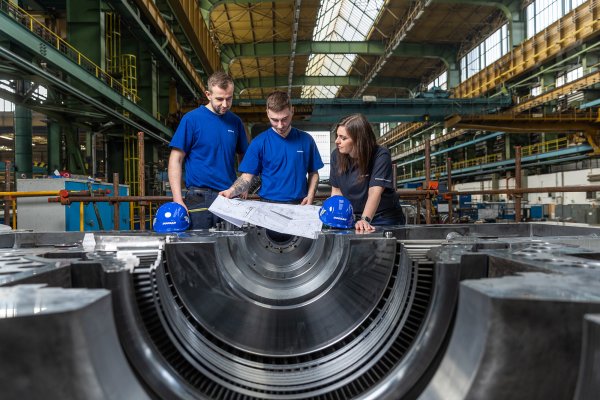"Being part of the multinational Doosan Group has been a great benefit for us. In the very first months, we became a turbine subcontractor for Doosan’s general contractor in Israel. Asian partners were more eager to cooperate, and we saw open doors to major Korean EPC contractors. At the same time, the new owner chose us as their global research and development centre for steam turbines," says Daniel Procházka, Chief Operations Officer of Doosan Škoda Power.
"The global company Doosan Heavy Industries and Construction decided to acquire Škoda Power mainly to expand its portfolio with a highly competitive product developed with unique technology and more than a century of know-how. Koreans did produce steam turbines before, but they were linked to external technologies under license."

JUDr. Daniel Procházka, Chief Operations Officer of Doosan Škoda Power
Orders worth 8.5 billion per year
Between 2007 and 2010, the company had many projects to modernize the domestic energy industry. "Following the acquisition, which was completed in 2010, the international market opened up to us in an unprecedented way. Although we produce highly sophisticated machines, which form a key part of the project and represent up to 20% of the investment unit’s total price, we operate on a subcontractor basis. Our partner is always either a power plant or a general contractor - EPC contractor. Following the acquisition, we were accepted as part of another strong Korean player by such powerful entities as, for example, Samsung, Hyundai, Daewoo, SK Group or Lotte.
We currently benefit most from these ties in South Korea, Spain and Turkey, but we have also had success with Hyundai and SK Group in Colombia, Uruguay, Chile and Panama. We have also achieved very good results in Europe, including countries like Sweden, Finland, Denmark, Spain and even Germany, despite the strong position of their national champion Siemens, and recently also Poland. In the last five years, we have seen annual growth of 10-15% every year. In 2020 the value of orders was around four billion, while last year they already jumped to eight and a half billion," says the manager, who spent twenty-two years in various positions in the company.
Customers usually find us by themselves
The company's sales team consists of members of several nationalities, and Daniel Procházka says that he no longer recalls an internal meeting conducted in Czech. The team is structured by region – one for Europe, one for Asia, one for America. With the growing interest in carbon-free energy across the globe, a nuclear power plant project department was set up a few years ago. But that’s nothing new for Doosan Škoda Power. Historically, about 20% of the company's production went to the nuclear sector. "We are thus responding to the growing demand for both large nuclear reactors and small modular reactors. Our experts have been developing these for several years."
The sales team members are actively searching for business opportunities, but in most cases customers address Škoda Doosan Power by themselves. The company then prepares an offer for the potential client for the most suitable product, which involves hundreds of hours of work by engineers and negotiations between salespeople and customers, and whose price normally ranges up to six million CZK. The complexity and demands of the bidding phase of the business case is evidenced by a maximum of twenty customized projects that the company implements annually.

Steam turbines, solar and nuclear
Which products get the highest demand? "We produce turbines with an output in the range of approximately 5 to 1,300 MW, so it is hard for me to choose a standout product. To evaluate market success, we typically look at client interest in applications, where our product is most in demand or is most innovative. In general, investors usually prefer blocks with combined production of electricity and heat, capable of working with various types of fuel, including waste, and so-called combi cycles with gas turbines, which can respond flexibly to power changes within the network. One example of an order that had high technical and business value for us is a steam turbine which we supplied for a concentrated solar power plant in the Atacama desert, Chile, with an output of 110 megawatts. It is a technology of concentrated solar with storage, where with the help of liquid salts it is possible to generate electricity from the sun for up to 16 hours a day, as conventional power plants do. This solution is an interesting opportunity for Chile and other South American countries to obtain energy from renewable sources. I should also mention the modernization of the Temelín nuclear power plant which took place between 2010 and 2016. We are also happy about the recent contract for a steam turbine for Covanta, US supplier of waste incineration plants, or another contract for the modernization of low-pressure turbines in the Finnish nuclear power plant Loviisa, the implementation of which is expected from 2026.”
Engineering invention combined with state-of-the-art software
The company’s sophisticated production with high added value and important position within the Doosan Group are reflected in the staff structure at the Doosan Škoda Power plant and the financial support from the HQ, which has sent a significant amount of funds to Pilsen and strengthened its personnel base.
"We focus on solutions that increase efficiency, are environmentally friendly and have higher effectiveness in the use of raw material inputs. To verify turbine quality, we use our own test centre, the only one of its kind in Central Europe, which uses steam supplied by a neighbouring power plant," the operations director explains, pointing out the possibility of creating real-world conditions for testing.
Young people must be offered a clear perspective
Investors across tech fields complain about the lack of qualified young professionals. "There aren't enough of them, but I wouldn't be so pessimistic. In engineering study programs, however, there must be a reasonable balance between general disciplines and specializations. This is even more important in a field as complex as turbines. That is why we have cooperated closely with a number of technical universities for years.
In Pilsen, it is the University of West Bohemia, where I serve on the board of directors. The university has a study program called Design of Power Machines and Equipment, which they run in cooperation with our company, academic institutions and smaller specialized companies. As one of the largest employers in the Pilsen region, we also target secondary school students, with the technical education trade fair Study Map Day, for example.
We operate our own training centre for up to twenty-five people, equipped with state-of-the-art technology. We have invested around twenty-five million CZK in the training centre and use it to expand the necessary skills of students in the second and third years of secondary technical schools and vocational schools, as these are our potential workers."
Written by Věra Vortelová
Photo credits: Doosan Škoda Power


 Jižní Korea
Jižní Korea

